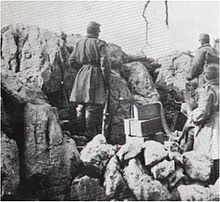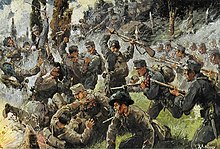Fourth Isonzo Battle
| date | November 9, 1915 to December 15, 1915 |
|---|---|
| place | Place Plava to the Adriatic Sea |
| output | Italian offensive fails |
| Parties to the conflict | |
|---|---|
| Commander | |
|
|
|
| Troop strength | |
| 155 battalions 626 guns |
370 battalions 1,374 guns |
| losses | |
|
Dead: 4,000 |
Dead: 7,000 |
1915
1st Isonzo - 2nd Isonzo - 3rd Isonzo - 4th Isonzo - Lavarone (1915-1916)
1916
5th Isonzo - South Tyrol offensive - 6th Isonzo - Doberdò - 7. Isonzo - 8. Isonzo - 9th Isonzo -
First Dolomites Offensive - Second Dolomites offensive -
Avalanche disaster
1917
10th Isonzo - Ortigara - 11th Isonzo - 12th Isonzo - Pozzuolo - Monte Grappa
1918
Piave - San Matteo - Vittorio Veneto
The fourth Isonzo battle took place during the First World War between the armed forces of Austria-Hungary and Italy between November 9 and December 15, 1915 in the area from the town of Plava (now Plave ) to the Adriatic Sea .
The attack phases
The fourth battle of the Isonzo can be divided into four parts:
- 9-13 November: Attacks in the entire front area from Plava to the Adriatic Sea
- 14.-15. November: fighting on the northern plateau of Doberdò
- 18.-22. November: Breakthrough attempt at Oslavija (today Oslavia, district of Gorizia )
- November 24–14. December: Breakthrough attempts in the entire section of the front
In a huge onslaught, the Italians tried again to conquer the Doberdo plateau and Gorizia . Gorizia was almost completely destroyed by Italian gunfire. This offensive did not bring the hoped-for success either, as all Italian attacks were repulsed. When winter fell, General Luigi Cadorna stopped the attacks.
Troop strengths
Attack groups
The 3rd Italian Army under the command of General Duke of Aosta was deployed in the Gorizia section and the 2nd Army under General Pietro Frugoni in the area of Monte Krn . These were: 370 battalions of infantry (Italian = Fanti), Alpini , Bersaglieri , Zappatori and Artiglieri with 1,374 guns .
Defense troops
The front area belonged to the section Army Group - General of the Cavalry Rohr / 5th Army - General Boroevic / Area of the 93rd Infantry Troop Division - Major General Boog and 57th Infantry Troop Division - Field Marshal Lieutenant Goiginger with These were: 155 battalions of infantry , hunters , Landwehr , Honvéd , Bosniaks , Pioneers and artillerymen with 626 guns.
backgrounds
The Fourth Isonzo Battle is also known as the "Parliamentary Battle". The Italian Commander-in-Chief General Luigi Cadorna wanted under all circumstances and regardless of possible losses to force a success before the parliamentary elections, because the catastrophic failures so far threatened to plunge Italy into a domestic political crisis.
location
9-13 November
Supported by massive artillery on the other bank of the Isonzo, the Italians first tried to advance towards Monte Santo and Monte San Gabriele near Plava and over the village of Zagora and the 611 m high Kuk mountain . The two mountains on the left side of the Isonzo tower over the valley of Gorizia, revealing the Italians' intention to bypass this valley from the north. After seven rushes, Italian forces were able to penetrate the southern part of Zagora on November 10, but were driven out of it again on November 11. Further attacks were unsuccessful. The first Italian attack carried out on Monte Sabotino got stuck in massive defensive fire, and further efforts did not lead to success. Assaults on the village Oslavija that tight on the right bank of the Isonzo in the North Valley of Podgora position between the Sabotino and Padgorahöhe is on the road to Gorizia were from "Krainerischen Infantry Regiment, Knights of clemency 'no. 17" repulsed . Italian reserves , which were to be brought in from the Lucinico area, were being wiped out by the Austro-Hungarian artillery on the march.
Fierce hand-to-hand fighting took place on the Doberdo plateau on November 10th and 11th. Italian infantry began the attacks around 11:00 in the morning and continued without result until dark. At Peteano, the attackers were unable to penetrate the barrage zone after a first attempt and remained in front of it. On the northeast slope of Monte San Michele , the Italian infantry temporarily captured a piece of trench, but this could not be held. In the section of the San Martino the "Hungarian Infantry Regiment 'Freiherr von Conrad' No. 39" from Vienna and Debrezin, as well as the "Hungarian Infantry Regiment No. 46" from Szeged and Avtovac (Bosnia) were in the heaviest fire. Here the trenches were defended and maintained in bitter hand-to-hand combat. Further south on Monte dei sei Busi was the Styrian " kk Landwehr Infantry Regiment No. 26" from Marburg and Cilli. On November 10, it repulsed five Italian assaults alone. It is guaranteed that the Styrians provoked the Italian officers to the extreme with shouts of "Avanti, avanti" before each impending attack, whereupon they drove the men forward and made them storm the Austro-Hungarian trenches almost uncovered. All five attacks collapsed in the crossfire of the machine guns .
14.-15. November
Opposite Monte San Michele, which was the subject of the second section of the battle, Monte Fortin rises on the other bank, the Italian side, of the Isonzo . This mountain was peppered with artillery, under whose protection the attackers tried on November 14th to capture Monte San Michele. They were able to penetrate individual trench sections on the northern slope, but were forced out again when counter-attacks were immediately carried out. A repetition of the attack the next day, this time carried out as a pincer movement, brought only limited success here too. Some trench sections that had been captured had to be cleared towards evening due to Austro-Hungarian counterattacks.
18.-22. November
Here the Italians began a breakthrough attempt at Oslavija on the St. Florian-Pevma-Görz road. Individual Italian storm columns were able to penetrate as far as the Austro-Hungarian defensive trenches, but were repulsed here in close combat. Before Oslavija over 1,000 attackers were counted dead. A former Austrian position, which had been captured by the Italians in a previous combat operation and then greatly expanded, was then taken under concentric fire by the Austro-Hungarian artillery. This weakened the morale of the crew to such an extent that a weak division of Infantry Regiment No. 17 under the command of Reserve Lieutenant Dr. Josef Freitag was able to conquer the fortified position without losses and capture the crew. Further positions were taken by departments of the "Bohemian Infantry Regiment Archduke Leopold Salvator No. 18" from Königgrätz and Nevesinje and the "Galician Infantry Regiment Philipp Herzog von Württemberg No. 77" from Sambor and Tuzla. On November 28 and 29, the Italians tried twice to recapture the lost positions, but could not pass the Austrian barrage belt and had to break off the attacks.
November 24–14. December
During this period the army of the Duke of Aosta tried again in ongoing attacks to achieve a noteworthy success. Several unsuccessful attempts have been made to capture Monte San Michele and Monte San Martino. The Italians' only lasting success was the conquest of the back of the church at Oslavija, but this was in no relation to the effort made. After that the battle slowly subsided, and on December 17th the Austro-Hungarian General Staff declared the battle over.
swell
- Austrian State Archives / Vienna War Archives
Footnotes
- ↑ However, writing of the kuk Militäradministratur to 1918 since the spelling reform of 1996 as Field Marshal Lieutenant referred
literature
- L'esercito italiano nella grande guerra (1915–1918) Volume I – IV / Roma: Ministerio della Guerra - Ufficio Storico, 1929–1974
- Ministero della Guerra Stato Maggiore centrale - Ufficio Storico. Guerra Italo-Austriaca 1915-18. Le medaglie d'Oro . Volume secondo - 1916. Roma: 1923
- Casimir Hermann Baer: The War of Nations. Hoffmann, Stuttgart 1917, Volume 11: Third half of the war: from August 1915 to February 1916.




